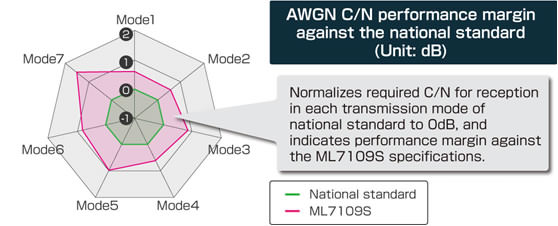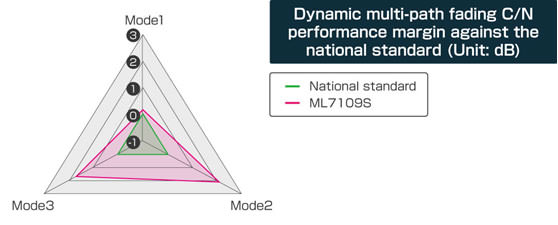2012 News Release
February 29, 2012
LAPIS Semiconductor starts sample shipment of demodulation LSI accordance with China digital terrestrial broadcasting standard
 Excellent and stable reception performance under several conditions with low power consumption and small package
Excellent and stable reception performance under several conditions with low power consumption and small package
LAPIS Semiconductor, a subsidiary of ROHM Group, has developed a demodulation/error correction LSI “ML7109S” best suited for TV sets or set top boxes that receive the broadcasts in accordance with the China digital terrestrial broadcasting standard GB20600-2006 (DTMB)(*1).
This product supports all 330 transmission modes specified in the DTMB standard and meets the demodulation and channel decoding requirements of GB/T 26685-2011 and GB/T 26686-2011(*2). Additionally, this product can offer excellent and stable reception performance at transmission parameters not stated in the standard. This product has achieved this highly stable reception performance with the lowest consumption, and also it helps reduce the mounting area using the internal memory needed for decoding.
Sample shipment of this product has started already, and mass production is planned to start gradually from January 2012.
In China, transition from an analog to digital broadcasting is proceeding at a fast pace. In the vast expanse of land, digital terrestrial or satellite broadcasting is planned to cover from the urban area to rural area, thus the digital terrestrial broadcasting market is expected to grow rapidly in the future.
LAPIS Semiconductor has been dedicated in development of reception LSIs designed for Japanese digital terrestrial broadcasting system ISDB-T. The accumulated experience in digital terrestrial broadcasting related matters and thorough research conducted with the development site in China on China-specific requirements have helped us manage to launch this product in a short time.
Yang Zhixing, a professor at Tsinghua University and one of proponents of China digital terrestrial broadcasting standard, says:
“Since technical cooperation between Tsinghua University and ROHM began in 2008 to develop a reception LSI (DTMB Demodulator) designed for Chinese digital terrestrial broadcasting, LAPIS Semiconductor (a subsidiary of ROHM Group) has achieved significant successes in quality, stability, receiver sensitivity and low power consuming performance for reception LSI.
This LSI is a new product of LAPIS Semiconductor, and its receiver sensitivity and low power consumption, in particular, have reached the industry’s highest level. This is also the fruit of long-term technical cooperation between Tsinghua University and ROHM. This product is suitable for digital TV sets, set top boxes (STB) and TV receiver USB dongles.”
LAPIS Semiconductor plans to develop a demodulation/decoding LSI equipped with demodulation function for cable TV sets which will be spread to urban areas in China, and help reduce the number of needed components of digital TV set. And will also work on supporting the digital terrestrial broadcast reception in other overseas areas.
Features
- Meeting the demodulation and channel decoding requirements of GB/T 26685-2011 and GB/T 26686-2011
This product supports both the single-carrier and multi-carrier systems and provides high reception performance for both systems. - Excellent performance
This product provides stable reception performance in all reception conditions. The following characteristics, in particular, provide excellent performance.- AWGN (Additive White Gaussian Noise)
- Dynamic multi-path fading

The dynamic multi-path fading is a model of the propagation conditions in urban areas. It indicates that stable reception can be provided even when the reception condition changes, in a location similar to the actual reception condition where multiple broadcasting waves arrive after reflecting off buildings or other objects.
This product provides stable reception performance also for Modes 4-7 which are not stated in the standard.

- Steady reception in the field
In some areas in China, simultaneous broadcasting service from multiple transmitting stations using the same frequency, which is called SFN (Single Frequency Network), has started to enhance the frequency usage efficiency. We selected places with reception difficulty caused by this service, and conducted repeated field test and made continual improvements on the unique algorithm to achieve stable high performance. - Low power consumption
The power consumption under reception has achieved 270mW, the industry’s highest level, by optimizing the operating frequency of each circuit and using the clock control technique, as well as miniaturizing the circuit by thorough optimization process. This will help heat dissipation which is important for flat TVs and contribute to ecological sets. - Package lineup meeting market demands
Small package contributes to reduced mounting area: 64pin WQFN (9mm × 9mm)
Applicable to inexpensive 2-layer board: 100pin QFP (14mm × 14mm)
Both packages include internal memory needed for decoding. - Turnkey evaluation kit
We provide a simple system of digital terrestrial broadcast receiver consisting of tuner, ML7109S, backend decoder and driver software for easy evaluation.
Field of application
- Digital TV sets, set top boxes, USB dongles
Sales plan
- Product name: ML7109S
- Sample shipment: Currently being supplied
- Sample price: Yen 600 (tax not included)
- Mass production plan: January 2012
Overview/features
- Compliant with China digital terrestrial broadcasting standard GB20600-2006
Supports all 330 transmission modes. - Meeting the demodulation and channel decoding requirements of GB/T 26685-2011 and GB/T 26686-2011
- Equipped with the memory needed for decoding
- External interface
Wide range IF
Standard IF, Low-IF and Zero-IF supported
RF/IF Dual AGC
IF AGC analog output option available
Parallel/serial MPEG-2 TS interface
I2C-bus slave function for host controller
I2C-bus repeater function to the tuner
GPIO
The main clock is compatible with external 30.4MHz/31.12MHz crystal oscillator input. - Power consumption
Reception 270mW - Power voltage
Analog and digital I/O 3.0V to 3.6V (Typ. 3.3V)
Core voltage 1.1V to 1.3V (Typ. 1.2V) - Operating temperature -20°C to +85°C
- Package
64pin WQFN (9mm × 9mm, Pitch 0.5mm)
100pin QFP (14mm × 14mm, Pitch 0.5mm)
Lead-free, RoHS compliant
Glossary
- *1: GB20600-2006 (DTMB)
- This is a Chinese digital terrestrial broadcasting standard. Total 330 transmission modes are specified.
- *2:China national standards for receiver (GB/T 26685-2011 and GB/T 26686-2011)
- These are receiver standards set up by the China Ministry of Information Industry.
*The names of companies and products described in this article are the trademarks or registered trademarks of the respective companies and organizations.
Contact
For customers' inquiry regarding this release: please go to ![]() the inquiry page
the inquiry page
* Information in the press releases is current on the date of the press announcement, but is subject to change without prior notice.
*Please note that the names of companies and products described in this document are the trademarks or registered trademarks
of their respective companies and organizations.


